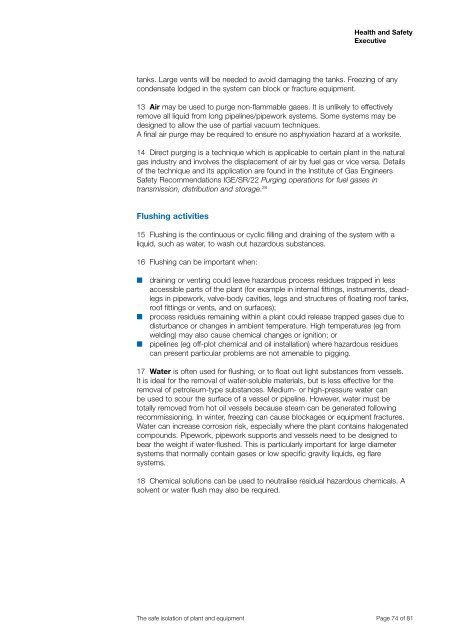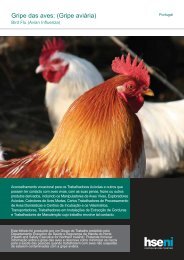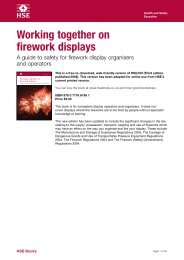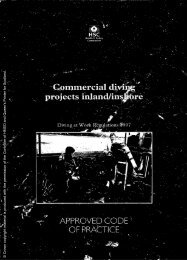The safe isolation of plant and equipment (HSG253) - Health and ...
The safe isolation of plant and equipment (HSG253) - Health and ...
The safe isolation of plant and equipment (HSG253) - Health and ...
You also want an ePaper? Increase the reach of your titles
YUMPU automatically turns print PDFs into web optimized ePapers that Google loves.
<strong>Health</strong> <strong>and</strong> Safety<br />
Executive<br />
tanks. Large vents will be needed to avoid damaging the tanks. Freezing <strong>of</strong> any<br />
condensate lodged in the system can block or fracture <strong>equipment</strong>.<br />
13 Air may be used to purge non-flammable gases. It is unlikely to effectively<br />
remove all liquid from long pipelines/pipework systems. Some systems may be<br />
designed to allow the use <strong>of</strong> partial vacuum techniques.<br />
A final air purge may be required to ensure no asphyxiation hazard at a worksite.<br />
14 Direct purging is a technique which is applicable to certain <strong>plant</strong> in the natural<br />
gas industry <strong>and</strong> involves the displacement <strong>of</strong> air by fuel gas or vice versa. Details<br />
<strong>of</strong> the technique <strong>and</strong> its application are found in the Institute <strong>of</strong> Gas Engineers<br />
Safety Recommendations IGE/SR/22 Purging operations for fuel gases in<br />
transmission, distribution <strong>and</strong> storage. 28<br />
Flushing activities<br />
15 Flushing is the continuous or cyclic filling <strong>and</strong> draining <strong>of</strong> the system with a<br />
liquid, such as water, to wash out hazardous substances.<br />
16 Flushing can be important when:<br />
■<br />
■<br />
■<br />
draining or venting could leave hazardous process residues trapped in less<br />
accessible parts <strong>of</strong> the <strong>plant</strong> (for example in internal fittings, instruments, deadlegs<br />
in pipework, valve-body cavities, legs <strong>and</strong> structures <strong>of</strong> floating ro<strong>of</strong> tanks,<br />
ro<strong>of</strong> fittings or vents, <strong>and</strong> on surfaces);<br />
process residues remaining within a <strong>plant</strong> could release trapped gases due to<br />
disturbance or changes in ambient temperature. High temperatures (eg from<br />
welding) may also cause chemical changes or ignition; or<br />
pipelines (eg <strong>of</strong>f-plot chemical <strong>and</strong> oil installation) where hazardous residues<br />
can present particular problems are not amenable to pigging.<br />
17 Water is <strong>of</strong>ten used for flushing, or to float out light substances from vessels.<br />
It is ideal for the removal <strong>of</strong> water-soluble materials, but is less effective for the<br />
removal <strong>of</strong> petroleum-type substances. Medium- or high-pressure water can<br />
be used to scour the surface <strong>of</strong> a vessel or pipeline. However, water must be<br />
totally removed from hot oil vessels because steam can be generated following<br />
recommissioning. In winter, freezing can cause blockages or <strong>equipment</strong> fractures.<br />
Water can increase corrosion risk, especially where the <strong>plant</strong> contains halogenated<br />
compounds. Pipework, pipework supports <strong>and</strong> vessels need to be designed to<br />
bear the weight if water-flushed. This is particularly important for large diameter<br />
systems that normally contain gases or low specific gravity liquids, eg flare<br />
systems.<br />
18 Chemical solutions can be used to neutralise residual hazardous chemicals. A<br />
solvent or water flush may also be required.<br />
<strong>The</strong> <strong>safe</strong> <strong>isolation</strong> <strong>of</strong> <strong>plant</strong> <strong>and</strong> <strong>equipment</strong> Page 74 <strong>of</strong> 81







